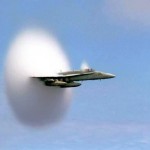Let’s review interference and nodes for a minute…
How waves interact with each other depends on whether the waves are in phase or not. If they are in-step (in phase) with each other, then it’s easy to add up to double the displacement (constructive interference). If they are completely out of step, then they cancel each other out (destructive interference). We’ve seen this for transverse waves, but what about compression waves, like for sound waves?
Please login or register to read the rest of this content.

 Sound can change according to the speed at which it travels. Another word for sound speed is pitch. When the sound speed slows, the pitch lowers. With clarinet reeds, it’s high. Guitar strings can do both, as they are adjustable. If you look carefully, you can actually see the low pitch strings vibrate back and forth, but the high pitch strings move so quickly it’s hard to see. But you can detect the effects of both with your ears.
Sound can change according to the speed at which it travels. Another word for sound speed is pitch. When the sound speed slows, the pitch lowers. With clarinet reeds, it’s high. Guitar strings can do both, as they are adjustable. If you look carefully, you can actually see the low pitch strings vibrate back and forth, but the high pitch strings move so quickly it’s hard to see. But you can detect the effects of both with your ears.